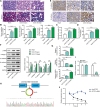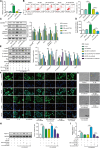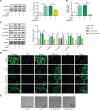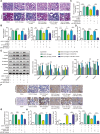CircACTR2 in macrophages promotes renal fibrosis by activating macrophage inflammation and epithelial-mesenchymal transition of renal tubular epithelial cells
- PMID: 35449370
- PMCID: PMC11072867
- DOI: 10.1007/s00018-022-04247-9
CircACTR2 in macrophages promotes renal fibrosis by activating macrophage inflammation and epithelial-mesenchymal transition of renal tubular epithelial cells
Abstract
The crosstalk between macrophages and tubular epithelial cells (TECs) actively regulates the progression of renal fibrosis. In the present study, we revealed the significance of circular RNA ACTR2 (circACTR2) in regulating macrophage inflammation, epithelial-mesenchymal transition (EMT) of TECs, and the development of renal fibrosis. Our results showed UUO-induced renal fibrosis was associated with increased inflammation and EMT, hypertrophy of contralateral kidney, up-regulations of circACTR2 and NLRP3, and the down-regulation of miR-561. CircACTR2 sufficiently and essentially promoted the activation of NLRP3 inflammasome, pyroptosis, and inflammation in macrophages, and through paracrine effect, stimulated EMT and fibrosis of TECs. Mechanistically, circACTR2 sponged miR-561 and up-regulated NLRP3 expression level to induce the secretion of IL-1β. In TECs, IL-1β induced renal fibrosis via up-regulating fascin-1. Knocking down circACTR2 or elevating miR-561 potently alleviated renal fibrosis in vivo. In summary, circACTR2, by sponging miR-561, activated NLRP3 inflammasome, promoted macrophage inflammation, and stimulated macrophage-induced EMT and fibrosis of TECs. Knocking down circACTR2 and overexpressing miR-561 may, thus, benefit the treatment of renal fibrosis.
Keywords: Epithelial–mesenchymal transition; Fascin-1; Macrophages inflammation; NLRP3; Renal fibrosis; circACTR2; miR-561.
© 2022. The Author(s), under exclusive licence to Springer Nature Switzerland AG.
Conflict of interest statement
The authors declare that they have no conflict of interest.
Figures









Similar articles
-
Circular RNA ACTR2 activates M2 polarization of macrophages through activating Yes-associated protein signalling and contributes to renal fibrosis.Immunology. 2022 Dec;167(4):606-621. doi: 10.1111/imm.13558. Epub 2022 Sep 7. Immunology. 2022. PMID: 36069177
-
C3a/C3aR synergies with TGF-β to promote epithelial-mesenchymal transition of renal tubular epithelial cells via the activation of the NLRP3 inflammasome.J Transl Med. 2023 Dec 11;21(1):904. doi: 10.1186/s12967-023-04764-6. J Transl Med. 2023. PMID: 38082306 Free PMC article.
-
NLRP3 inflammasome inhibition attenuates silica-induced epithelial to mesenchymal transition (EMT) in human bronchial epithelial cells.Exp Cell Res. 2018 Jan 15;362(2):489-497. doi: 10.1016/j.yexcr.2017.12.013. Epub 2017 Dec 16. Exp Cell Res. 2018. PMID: 29258746
-
The Role of NLRP3 Inflammasome Activation in the Epithelial to Mesenchymal Transition Process During the Fibrosis.Front Immunol. 2020 May 20;11:883. doi: 10.3389/fimmu.2020.00883. eCollection 2020. Front Immunol. 2020. PMID: 32508821 Free PMC article. Review.
-
Canonical and non-canonical effects of the NLRP3 inflammasome in kidney inflammation and fibrosis.Nephrol Dial Transplant. 2014 Jan;29(1):41-8. doi: 10.1093/ndt/gft332. Epub 2013 Sep 11. Nephrol Dial Transplant. 2014. PMID: 24026244 Review.
Cited by
-
Interaction Between Intrinsic Renal Cells and Immune Cells in the Progression of Acute Kidney Injury.Front Med (Lausanne). 2022 Jul 7;9:954574. doi: 10.3389/fmed.2022.954574. eCollection 2022. Front Med (Lausanne). 2022. PMID: 35872775 Free PMC article. Review.
-
Network Pharmacology Analysis and Machine-Learning Models Confirmed the Ability of YiShen HuoXue Decoction to Alleviate Renal Fibrosis by Inhibiting Pyroptosis.Drug Des Devel Ther. 2023 Oct 24;17:3169-3192. doi: 10.2147/DDDT.S420135. eCollection 2023. Drug Des Devel Ther. 2023. PMID: 37900883 Free PMC article.
-
CircUBXN7 promotes macrophage infiltration and renal fibrosis associated with the IGF2BP2-dependent SP1 mRNA stability in diabetic kidney disease.Front Immunol. 2023 Sep 6;14:1226962. doi: 10.3389/fimmu.2023.1226962. eCollection 2023. Front Immunol. 2023. PMID: 37744330 Free PMC article.
-
Role of miRNAs in macrophage-mediated kidney injury.Pediatr Nephrol. 2024 Dec;39(12):3397-3410. doi: 10.1007/s00467-024-06414-5. Epub 2024 May 27. Pediatr Nephrol. 2024. PMID: 38801452 Review.
-
Extracellular Vesicles in Renal Inflammatory Diseases: Revealing Mechanisms of Extracellular Vesicle-Mediated Macrophage Regulation.Int J Mol Sci. 2025 Apr 12;26(8):3646. doi: 10.3390/ijms26083646. Int J Mol Sci. 2025. PMID: 40332144 Free PMC article. Review.
References
MeSH terms
Substances
Grants and funding
LinkOut - more resources
Full Text Sources
Medical

